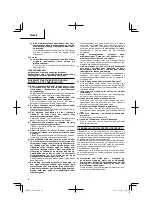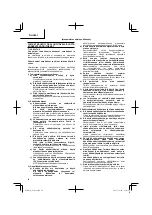
29
English
SPECIFICATIONS
Model
G10SQ
G12SQ
G13SQ
Voltage (by areas)*
(110 V, 120 V, 127 V, 220 V, 230 V, 240 V)
Power Input*
840 W
No-load speed
10000 min
-1
Wheel
Outer dia. × thickness × hole dia.
100 × 6 × 16 mm
115 × 6 × 22.23 mm
125 × 6 × 22.23 mm
Peripheral speed
72 m/s
80 m/s
Weight (Only main body)
1.6 kg
* Be sure to check the nameplate on product as it is subject to change by areas.
STANDARD ACCESSORIES
(1) Depressed center wheel ..............................................1
(2) Wrench .........................................................................1
(3) Side handle ..................................................................1
Standard accessories are subject to change without
notice.
APPLICATIONS
○
Removal of casting
fi
n and
fi
nishing of various types of
steel, bronze and aluminum materials and castings.
○
Grinding of welded sections or sections cut by means of
a cutting torch.
○
Grinding of synthetic resins, slate, brick, marble, etc.
PRIOR TO OPERATION
1. Power source
Ensure that the power source to be utilized conforms
to the power requirements speci
fi
ed on the product
nameplate.
2. Power switch
Ensure that the power switch is in the OFF position. If
the plug is connected to a receptacle while the power
switch is in the ON position, the power tool will start
operating immediately, which could cause a serious
accident.
3. Extension cord
When the work area is removed from the power source,
use an extension cord of su
ffi
cient thickness and rated
capacity. The extension cord should be kept as short as
practicable.
4. Fitting and adjusting the wheel guard
The wheel guard is a protective device to prevent injury
should the depressed center wheel shatter during
operation. Ensure that the guard is properly
fi
tted and
fastened before commencing grinding operation.
By slightly loosening the setting screw, the wheel
guard can be turned and set at any desired angle for
maximum operational e
ff
ectiveness. Ensure that the
setting screw is thoroughly tightened after adjusting the
wheel guard.
5.
Ensure that mounted wheels and points are
fi
tted in
accordance with the manufacturer’s instructions.
Ensure that the depressed center wheel to be utilized
is the correct type and free of cracks or surface
defects. Also ensure that the depressed center wheel
is properly mounted and the wheel nut is securely
tightened, Refer to the section on “ASSEMBLING
AND DISASSEMBLING THE DEPRESSED CENTER
WHEEL”.
Ensure that blotters are used when they are provided
with the bonded abrasive product and when they are
required.
Do not use separate reducing bushings or adaptors to
adapt large hole abrasive wheels.
For tools intended to be
fi
tted with threaded hole wheel,
ensure that the thread in the wheel is long enough to
accept the spindle length.
Do not use cutting o
ff
wheel for side grinding.
6. Conducting a trial run
Ensure that the abrasive products is correctly mounted
and tightened before use and run the tool at no-load
for 30 seconds in a safe position, stop immediately if
there is considerable vibration or if other defects are
detected.
If this condition occurs, check the machine to determine
the cause.
7. Con
fi
rm the push button.
Con
fi
rm that the push button is disengaged by pushing
push button two or three times before switching the
power tool on (See
Fig. 2
).
8. Fixing the side handle
Screw the side handle into the gear cover.
PRACTICAL GRINDER APPLICATION
1. Pressure
To prolong the life of the machine and ensure a
fi
rst
class
fi
nish, it is important that the machine should
not be overloaded by applying too much pressure. In
most applications, the weight of the machine alone is
su
ffi
cient for e
ff
ective grinding. Too much pressure
will result in reduced rotational speed, inferior surface
fi
nish, and overloading which could reduce the life of
the machine.
2. Grinding angle
Do not apply the entire surface of the depressed center
wheel to the material to be ground. As shown in
Fig. 1
,
the machine should be held at an angle of 15° – 30° so
that the external edge of the depressed center wheel
contacts the material at an optimum angle.
3.
To prevent a new depressed center wheel from digging
into the workpiece, initial grinding should be performed
by drawing the grinder across the workpiece toward the
operator (
Fig. 1 direction B
). Once the leading edge
of the depressed center wheel is properly abraded,
grinding may be conducted in either direction.
4. Switch operation
[When the switch has locking mechanism]
Switch ON: To switch on, slide the o
ff
lock lever in the
direction of A and press the switch lever in
the direction of B as shown in
Fig. 3-a
.
Furthermore, push the on lock button in
the direction of C shown in
Fig. 3-b
while
pressing the switch lever to lock and
enable continuous operation.
000Book̲G10SQ.indb 29
000Book̲G10SQ.indb 29
2017/12/04 12:03:51
2017/12/04 12:03:51








































